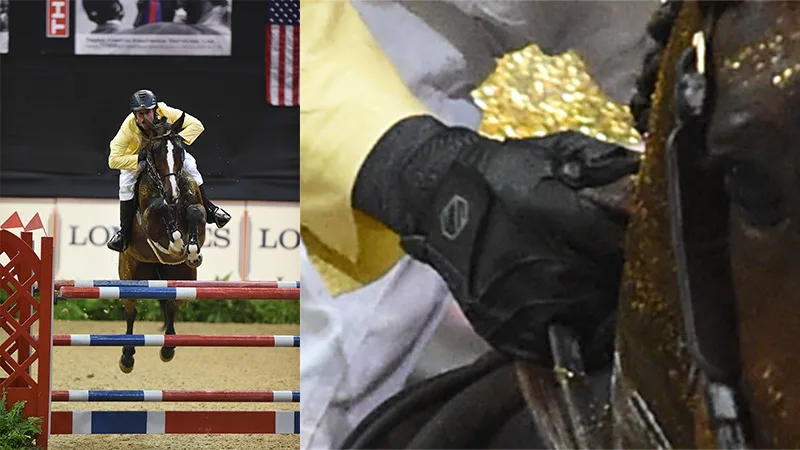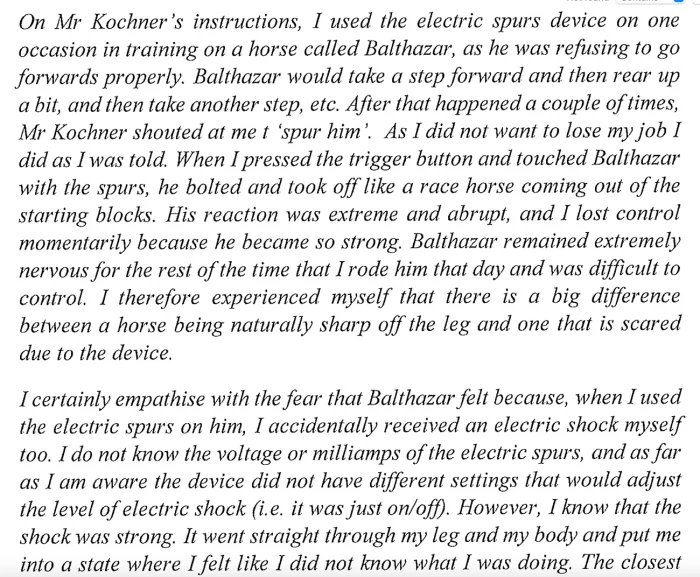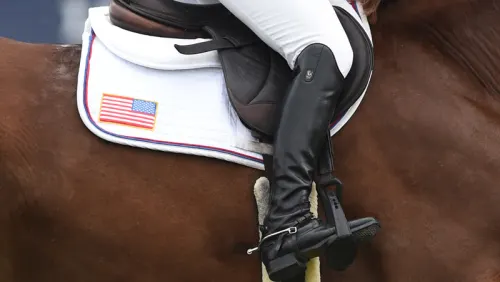This story has been updated to include details of the Court of Arbitration for Sport’s findings and a statement from the U.S. Equestrian Federation.
The Fédération Equestre Internationale announced Thursday, Oct. 12, that the Court of Arbitration for Sport has upheld its 2021 decision to suspend U.S. show jumper Andrew Kocher for 10 years for using electric spurs on various horses.
The CAS ruling was reached in June but made public today by the FEI. The document outlining its arbitration decision offers a new level of detail into the frequency with which Kocher used the spurs, as well as disassembling the rider’s argument that the trigger device he is seen holding in numerous photographs was a simple plastic clicker.
“We are extremely satisfied with this outcome and that the sanctions the FEI Tribunal imposed, to reflect the severity of the offenses committed by Mr. Kocher, have been upheld by CAS,” said FEI Legal Director Mikael Rentsch. “It may have taken two years to complete this process, but it confirms that we had the right decision to start with, and that there is no room for leniency when it comes to cases of horse abuse.

“We have rules and regulations in place to protect the integrity of our competitions and the wellbeing of our horses, and when these rules are breached and their welfare is jeopardized, we will continue to seek to impose maximum sentences,” he added.
Kocher is barred from participating in or attending, in any capacity, including as a spectator, any competition or event that is authorized or organized by the FEI or any National Federation until Oct. 27, 2030. The provisional suspension that he began in October 2020, when the FEI opened disciplinary proceedings, will be credited against this period of suspension. His results from eight FEI events between June 2018 and November 2019, where evidence supported his use of electric spurs, were disqualified, and he has been ordered to pay fines and legal costs totaling 17,500 Swiss francs (about $19,400).
The U.S. Equestrian Federation also honors the suspension. Kocher complained during his CAS hearing that USEF “has exceeded its authority by preventing the registration of horses he might be in a position to sell.”
“USEF prioritizes horse welfare and stands behind the CAS decision upholding the FEI’s sanction of Andy Kocher,” USEF spokeswoman Vicki Lowell said in an email. “Andy Kocher is suspended and ineligible to participate at USEF competitions in any manner including as a spectator. Additionally, all horses owned by Andy Kocher are ineligible to compete.”
Unlike the FEI Tribunal, which is made up people with specific expertise in equestrian sports, the three-member CAS panel was made up of professional arbitrators, whose expertise is in law. CAS arbitrates cases from all varieties of sport, with equestrian sports making up just a fraction of its caseload.
In its 37-page arbitral award, CAS outlines the basis of Kocher’s appeal to the FEI Tribunal’s 2021 decision and goes through its process and the evidence heard during a two-day hearing held Nov. 9 and 10 at its offices in Lausanne, Switzerland. Representatives and witnesses from the FEI, which also is based in Lausanne, appeared in person, while Kocher and his attorney appeared via video conference.
‘Adversarial’ Relationship Between Kocher And Whistleblower
The full text of the CAS arbital award includes details of the case not previously made public, including confirming that Kocher first was reported in the independent Equestrian Community Integrity Unit in June 2020 by his former business partner, Eye Candy Jumpers owner Erica Hatfield. Hatfield told the ECIU that Kocher had used electric spurs on a number of FEI-registered and national horses in international and national events, and during training. She provided the ECIU with approximately 500 photos, as well as key video evidence that showed a shock device and explained how it worked and video of a pair of Kocher’s old riding boots that showed holes cut in them where wires allegedly would run through to electrify the spurs.
The FEI called one veterinarian as an expert witness and several eyewitnesses—Hatfield as well as another professional rider and three other people who were not identified by named “because they were young assistants who worked under the supervision and instruction of [Kocher] and may, if identified, run the risk of being associated with his wrongdoing.” The CAS panel noted the importance of making sure subordinate employees are not discouraged from revealing the actions of a person in a position of authority.
By contrast, the document indicates Kocher asked for multiple extensions to file his brief, and upon finally doing so submitted no admissible witnesses. Only three of the 23 “statements” he offered “related in substance to the treatment of horses,” the panel noted, and none were admissible as directly relating to the spur issue.
“After a lengthy series of contested extensions that lasted over half a year, [Kocher] finally filed his Appeal Brief of 24 February 2022,” stated the panel in writing. “Attached to it were so-called ‘witness statements’ in the form of unsigned and unverified copies of short emails or screenshots of emails.”
“Most of these ‘statements’ contained harsh criticism of Ms. Erica Hatfield … Her business relations with [Kocher] have become acutely contentious; they are engaged in U.S. court litigation.
ADVERTISEMENT
“It is clear without reference to these accounts that Ms. Hatfield and [Kocher] have a highly adversarial relationship, and that her assertions with respect to him (and indeed vice versa) are therefore subject to doubt unless confirmed by other probative evidence,” the panel continued.
The panel made clear that, while Hatfield instigated the investigation of Kocher and provided key photographic evidence against him, it did not give weight to her testimony at the hearing due to their contentious relationship.
CAS Focused On ‘Merits Of Case’
The panel also dismissed Kocher’s arguments related to what he deemed were numerous procedural errors made by the FEI in reaching its tribunal decision. The panel called those arguments “immaterial,” emphasizing that it makes its own “de novo” decision based on the full merits of the case and evidence presented to it, and it would not be looking at how the FEI tribunal reached its own ruling, the full text of which is available here.
Specifically, the CAS panel’s purpose was to determine whether Kocher was, in fact, guilty of breaking the rules of his sport—abusing horses through the use of prohibited electrified devices—and if so, whether the sanctions imposed by the FEI were proper in light of the gravity of the offense.
“The question is whether he used electrified spurs, and that is of course possible even if on other occasions he was engaged in innocent activity,” the panel wrote, referring to Kocher’s contention that he merely used a sound-emitting clicker, or an email statement he submitted from a rider saying they never saw him use the device. “Thus assertions by friendly witnesses to the effect that ‘I never saw him using an electric spur’ are not exculpatory.”
FEI Details ‘Deliberate, Methodical’ Abuse
Making its case in an appeal brief to CAS, the FEI offered a harsh assessment of Kocher: “This case involves the deliberate, methodical, and repetitive abuse of horses by [Kocher], a high-level professional show jumping rider and horse dealer, who not only abused many horses over many years using electric spurs both in training and in competition (a criminal act in many jurisdictions), but also instructed his employees to do the same, and make electric spur devices to give/sell to others.
“It also involves gross cheating to the detriment of equestrian sport,” the FEI continued, “because the electric spurs were used to enhance the performance of horses (through pain and fear) both for competitive advantage in show jumping and for commercial gain through the sale of horses. The deliberate and knowing conduct of [Kocher], who has a history of animal abuse and a complete disregard for horse welfare, is extreme and warrants severe punishment.”
Kocher Argues Eyewitnesses Biased
Kocher contended that witnesses testifying mistook a clicker for electrified spurs, which he referred to as “the rockets,” and contended that one of the former employees who testified against him was the person who actually used the spurs.
“[H]e admits that he did using [sic] the rockets to modify the horse’s behavior … I fired him,” Kocher testified, according to the CAS document. “In retaliation, he tells Erica Hatfield (my sworn business-legal-lawsuit-enemy!) that his device belongs to me and that I used that device.”
Part of the panel’s job, it noted, was to determine whether Kocher’s claims that evidence against him was convincing or, as he argued, questionable due to mistaken impressions or bias and animosity on the part of the witnesses.
“The Appellant’s claims of bias and animosity are of a wide range and tend to be very personal,” the panel noted. “He accuses adverse witnesses of harboring resentment toward him because of financial disputes or anger at having been dismissed from employment by him or (in one case) jealousy.”
Panel Dismantles Clicker Claim
In reaching its decision, the CAS panel said the most compelling evidence was visual—the FEI submitted 77 photos and frames of video—or testimonial.
Key among the visual testimony were various photos showing Kocher holding a trigger button while riding, the picture of his boot with a hole to feed a wire through to the spur, a picture of him riding Fashion V at a CSI2* in 2019 in which wires are visible running down the inside of his breeches.
ADVERTISEMENT
“The panel has reviewed those materials and is comfortably satisfied that they prove [Kocher’s] infraction,” the document states before eviscerating the rider’s defenses:
“The panel specifically rejects the credibility of [Kocher’s] alternative explanation that the trigger … is actually a homemade clicker crafted by the Appellant from a flashlight handle and secured by a string slung over his shoulder and affixed to his belt. This alleged assembly would seem entirely unnecessary to secure such a small plastic clicker of the type testified to by the Appellant. While the Appellant denied that the photo of the outline of a wire running down each of his legs was in fact a wire, [he] had no alternative theory for that depiction in the photo, or for the holes in each of his boots.”
Compared to the inadmissible statements Kocher sought to enter as testimony, the panel found the FEI’s witness compelling—with the exception of Hatfield, “whose stormy relationship with [Kocher] makes it difficult to consider her to be dispassionate,” and therefore whose testimony “was not given weight.”
The panel found the testimony of several riders who previously worked for him compelling, however.
One of the unnamed riders said they realized Kocher was using the electric devices about two months after starting to work for him. Another said they walked into the tack room their first day on the job to find him partially undressed with wires visible.
“Mr. Kocher’s use of electric spurs was not limited to occasional use on horses that had behavior problems (like stopping before a jump), rather he used them often on well-behaved horses as well to get more out of them (i.e. to make them quicker or more powerful, which often enabled them to jump in bigger classes than they might otherwise have done),” the first rider said.
The person testified to seeing Kocher go into a stall before a grand prix and loosen his breeches and shirt to feed the wires through them. He also testified that Kocher would talk about “making a new pair” and had a soldering gun in his trailer.
The person admitted that they used the spurs “a handful” of times in training rides, not competitions, at Kocher’s instruction, and that Kocher occasionally would tell them and three other riders working for him specifically which horses the spurs should be used on in training rides on a given day.
“I did once accidentally shock myself when using the device because I had not securely taped the exposed wire to my spur, and so the wire ended up inside my boot, touching my calf,” the person said, calling the experience “unpleasant and painful” and noting Kocher had given the rider that device while making a new one for himself because it “had lost some power.”
The person testified that when they refused to use the spurs in competition after a horse stopped in one class, Kocher pulled them off of showing that horse. They also expressed their regret for using the spurs and not reporting Kocher for using them.
The two other former employees offered similar testimony, with one offering a specific account of what happened when they used the spurs on a balking horse at Kocher’s instruction:

Along with the three former employees, the CAS panel heard testimony from a professional trainer who was never employed by Kocher. The trainer testified that he saw Kocher and a groom working on the electrical device in the stabling area at a show in 2014, after hearing a loud sound like a wire short-circuiting and running out of his stall worried an electrical fire might be starting in the barn.
The trainer said Kocher explained that the spurs were “running too hot” and explained how they worked and how he used them.
“I like Mr. Kocher personally and enjoy interacting with him. He is a tremendous talent and the hardest worker I have ever met in my life,” the trainer, who said he had known Kocher casually since childhood, testified. “When I saw this I should have reported it. When I saw that he was using this to compete at the highest levels of the sport and perhaps when representing the United States, I was beyond horrified. My hope was that he had risen beyond this. He certainly has the talent and work ethic to have done that.”
The panel found the trainer’s testimony particularly compelling in that he did not know any of the other eyewitnesses and yet his testimony, from a different time and place, about the spurs matched theirs.
“Considering the dual iniquity of cruelty to animals and disloyalty to competitors, as well as the actions of [Kocher] in not only using the spurs himself but also instructing or encouraging others to do so, the panel reaches the same conclusion as the FEI Tribunal to the effect that a 10-year suspension was merited, and entailing disqualification from eight events tainted by the evidence of infractions.”
Read the full CAS decision here.














